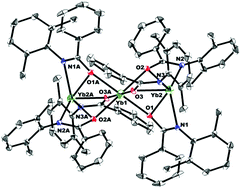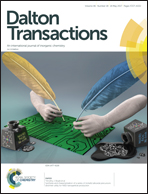An amidato divalent ytterbium cluster: synthesis and molecular structure, its reactivity to carbodiimides and application in the guanylation reaction†
Abstract
A divalent ytterbium amidate 1 ([Yb3L6]·2C7H8 for short) was synthesized via amine-elimination of Yb[N(SiMe3)2]2(TMEDA) with an amide proligand N-2,6-diisopropylphenylbenzamide HL (L = 2,6-iPr2C6H3NC(O)Ph) and structurally characterized to be a trinuclear symmetric cluster. Further studies on the reduction of iPrN![[double bond, length as m-dash]](https://www.rsc.org/images/entities/char_e001.gif) C
C![[double bond, length as m-dash]](https://www.rsc.org/images/entities/char_e001.gif) NiPr by complex 1 provide Yb(III) complex 2 in hexane–THF ([(YbL2)2(μ-NiPrCNiPr)][YbL3(THF)]·C7H8), which is composed of two subunits in a unit cell, one is a bridged Yb(III) carbene, just the same as complex 4 ([(YbL2)2(μ-NiPrCNiPr)]·3C7H8) obtained in the same reaction in toluene, and the other is a homoleptic monomeric Yb(III) amidate (YbL3). It is also found that complex 2 decomposed to complex 3 ([YbL3]2·2C7H8) and 4 at 90 °C in toluene. Complexes 1–4 were confirmed by X-ray structure determination. Furthermore, complex 4 was proved to be a more active species than its precursor 1 in the catalytic addition of amines to carbodiimides. Finally, complex 1 was found to be an excellent pre-catalyst for the guanylation reaction with a wide scope of substrates.
NiPr by complex 1 provide Yb(III) complex 2 in hexane–THF ([(YbL2)2(μ-NiPrCNiPr)][YbL3(THF)]·C7H8), which is composed of two subunits in a unit cell, one is a bridged Yb(III) carbene, just the same as complex 4 ([(YbL2)2(μ-NiPrCNiPr)]·3C7H8) obtained in the same reaction in toluene, and the other is a homoleptic monomeric Yb(III) amidate (YbL3). It is also found that complex 2 decomposed to complex 3 ([YbL3]2·2C7H8) and 4 at 90 °C in toluene. Complexes 1–4 were confirmed by X-ray structure determination. Furthermore, complex 4 was proved to be a more active species than its precursor 1 in the catalytic addition of amines to carbodiimides. Finally, complex 1 was found to be an excellent pre-catalyst for the guanylation reaction with a wide scope of substrates.



 Please wait while we load your content...
Please wait while we load your content...